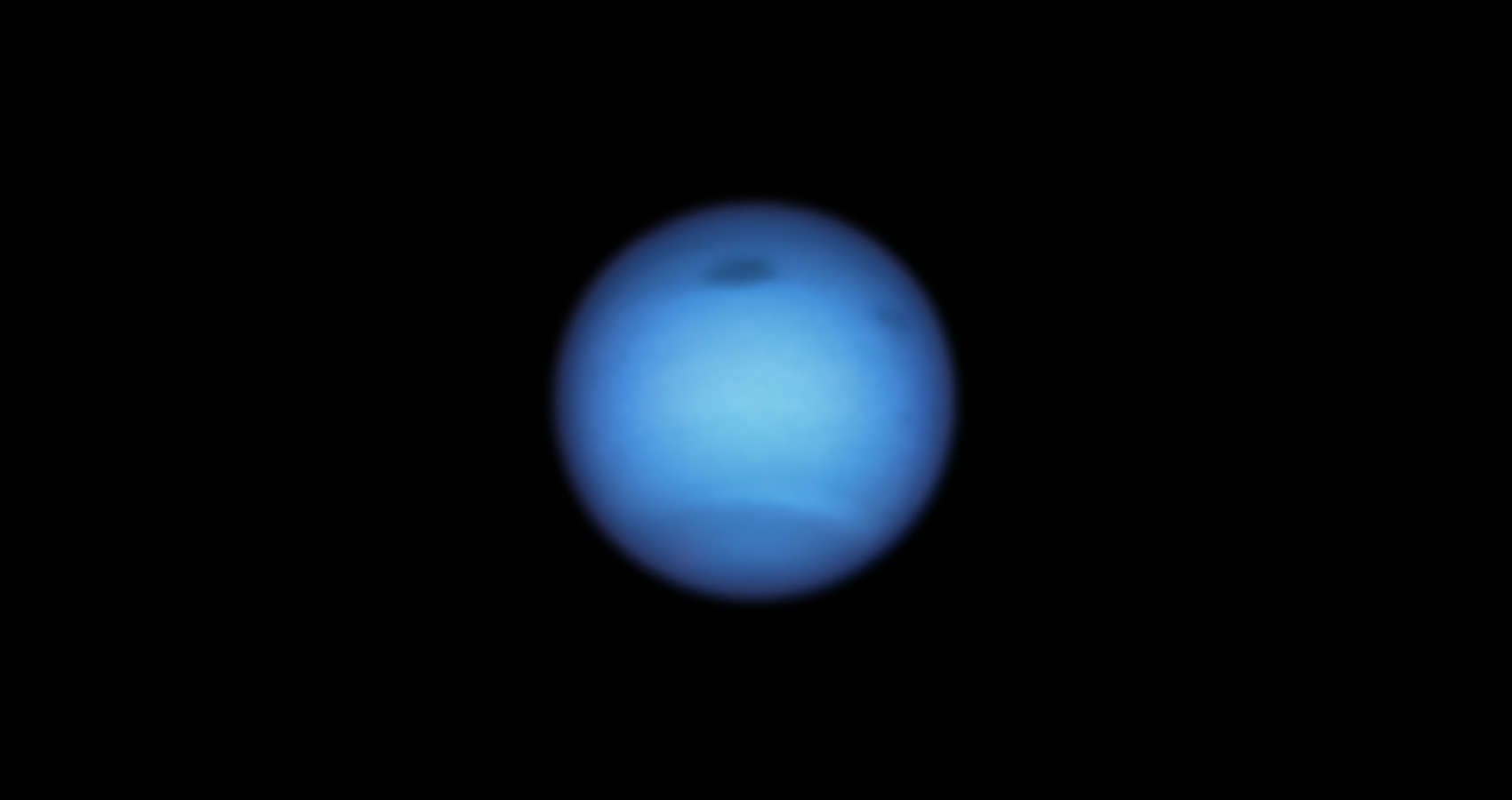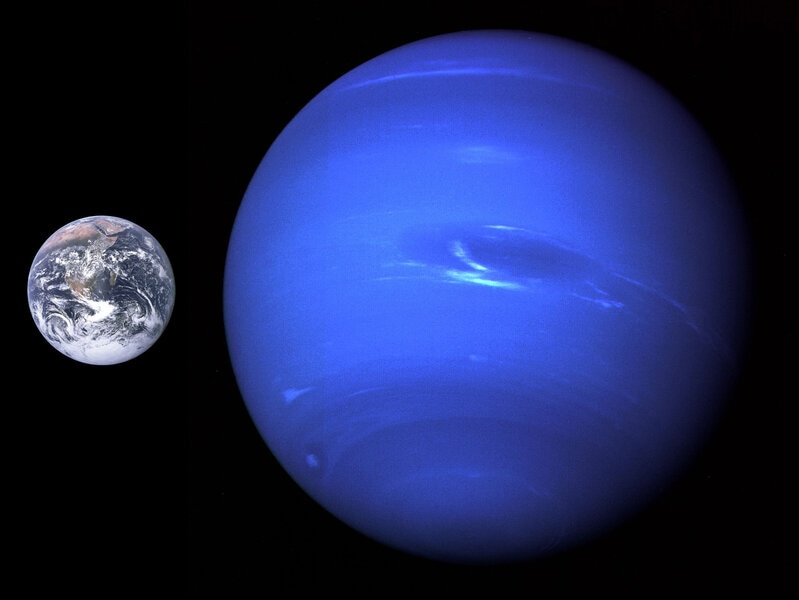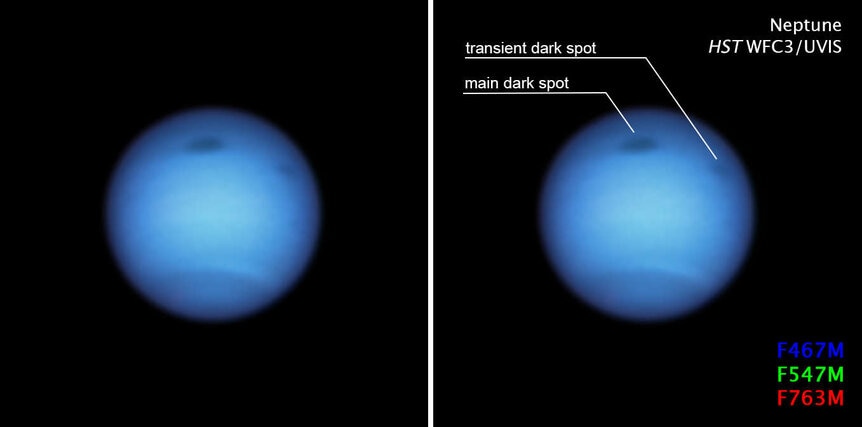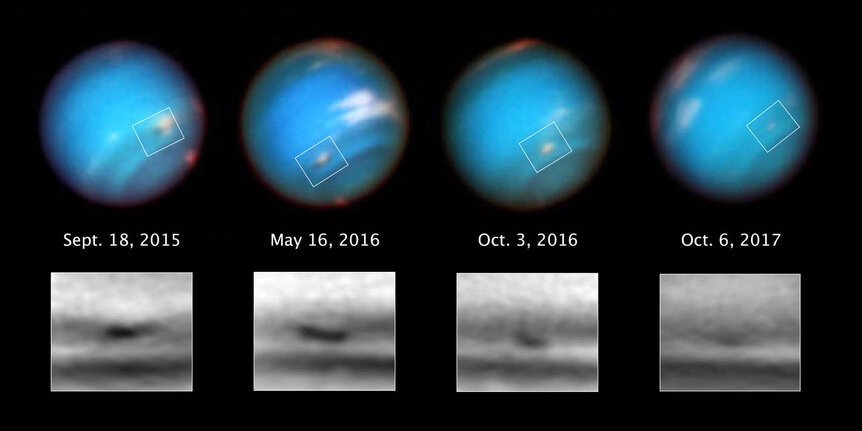Create a free profile to get unlimited access to exclusive videos, sweepstakes, and more!
Defying death, a monster storm on Neptune makes a U-turn

A series of observations of Neptune by Hubble Space Telescope show that a huge dark storm raging in the giant planet's northern hemisphere was moving south, but then inexplicably took a major U-turn, heading back north. Not only that, but it may have also spawned a baby dark storm in the process.
Neptune is what's called an ice giant, basically a gigantic ball of hydrogen and helium gas with loads of methane, ammonia, and other molecules in it (that for historical reasons, planetary scientists refer to as "ices" even if they're gaseous). At nearly four times the diameter of Earth, Neptune is farthest large planet from the Sun, 4.5 billion kilometers away.
When Voyager 2 passed by Neptune in 1989, the images it returned surprised scientists; it saw an immense oval dark storm in the planet's southern hemisphere as big as Earth itself! Called the Great Dark Spot, it had measured wind speeds of a staggering 2,100 kph, the fastest wind ever measured in the solar system.
But, when Hubble looked at Neptune in 1994, the spot was gone. Poof. Disappeared. Clearly, unlike Jupiter's Great Red Spot, which has persisted for centuries (at least), storms on Neptune evolve on smaller timescales, though they can last for several years. For example, in the same 1994 Hubble observations a smaller dark spot was seen in Neptune's southern hemisphere, one that must have been born in the intervening time between the Voyager flyby and the Hubble images.
Several other dark spots have been seen by Hubble (the only observatory with enough resolution to see these features from so far away) since. They form in both hemispheres in mid-latitudes, and tend to drift toward the equator. That's a death sentence for them, though.
These storms are high-pressure systems, sustained by the Coriolis effect — the rotation of a planet has a different speed at different latitudes (with a maximum at the equator and minimum at the poles), which means air flowing outward from a large high-pressure system (or in toward a low-pressure one) will start the system rotating as it meets air moving at different speeds to the north and south.
The Coriolis effect diminishes closer to the equator, so as these Neptunian storms migrate in that direction they tend to break up. That seems to be the fate of most of these storms.
But not this time. Hubble spied a dark storm in Neptune's northern hemisphere in September 2018. It's huge, over 7,000 kilometers wide — the entire continental United States could easily fit inside it — and it was seen to be moving south… but then observations taken in January 2020 showed that this southern migration had reversed itself, and the storm was moving north again. Scientists who study Neptune don't know why it did that.
But there's more: There are two other mysterious events seen associated with this storm. One is that around the time it changed its mind and started heading north again it appears to have spawned a smaller dark storm. Some computer models of the behavior of Neptune's atmosphere predict this can happen, especially as a big storm starts to break up near the equator; it can shed smaller vortices. This wasn't seen to happen directly — the observations were taken too far apart in time to witness the actual event — but it may be what occurred here. That may have something to do with why it changed direction.
Also, bizarrely, this dark storm doesn't have bright white clouds around its edges, a feature seen in nearly every other dark storm. These are clouds made of methane ice crystals, which are highly reflective and appear white in images. The dark storm is a high-pressure system and acts like a mound of air in the atmosphere; winds blow methane gas up the slopes of that mound where it cools and forms the ice crystals. These are called orographic clouds, and they're common on Earth as water-laden air blows up the side of a mountain, cools, and condenses to form clouds.
The Neptunian white clouds were seen in images taken in 2019, but disappeared early this year. This may have something to do with the dark storm's odd behavior. Or it might not! Neptune is difficult to observe and understand due to its distance, and despite its huge size it still appears very small in our telescopes. Also, its atmosphere changes on short timescales, making it hard to know what's going on there.
This is why scientists are very interested in creating a dedicated mission to the outer planets, an orbiter that can spend years first at Uranus and then moving on to orbit Neptune. Just as we found with Cassini at Saturn, the best way to learn about a planet is to send a probe that stays there for many years. Features come and go, things change, and just as importantly when scientists discover new phenomena that they can then tell the spacecraft to take a closer look. Discovering new things is important, but a dedicated mission means you can stick around and maybe figure out what's causing them.
That's the lesson we leaned from the Voyager flybys as well. Seeing Neptune up close for the first time allowed for discoveries like the dark storms, but if we want to understand them we need to go there to stay.





























